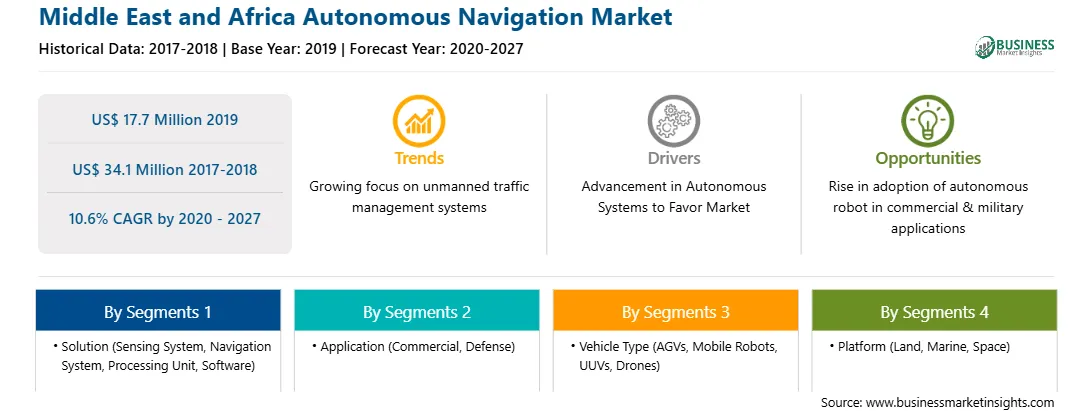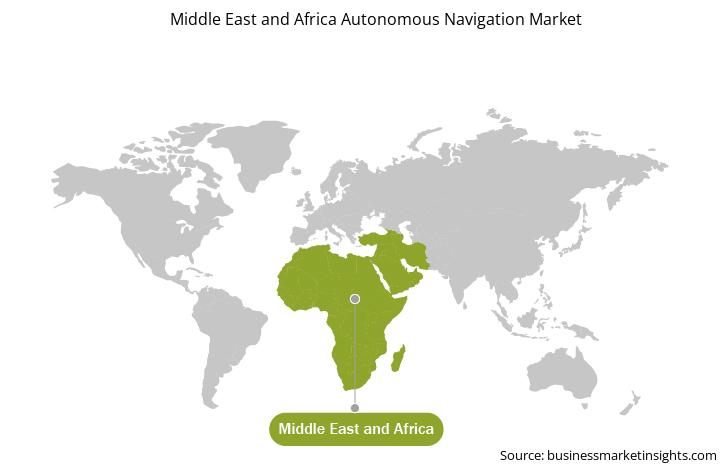The region is expected to witness a rapid rise in marketing and industrialization, further improving the diverse industries. Middle East and Africa includes South Africa, Saudi Arabia, the UAE, and Rest of MEA. The Middle East and African region is known to be a region with two halves of economies. The Gulf countries are economically developed countries whereas the African countries are yet to match up to the economic conditions of the Gulf countries and lag far behind. Poor economy and low adoption of technological advancement are the primary reasons for low acceptance of drone in the region. Certain countries in the region have started focusing on the domestic manufacturing of defense UAVs. For instance, in 2020, Marakeb Technologies collaborated with Prince Sultan Defense Studies & Research Center (PSDSARC), Saudi Arabia, to develop unmanned technologies. Also, Vessel navigation and unmanned ship getting deployed with autonomous navigation technology is driving the MEA autonomous navigation market.
The ongoing COVID-19 pandemic is impacting the MEA severely. Iran, Saudi Arabia, Qatar, South Africa, and the UAE are among the countries with high number of COVID-19 confirmed cases and reported deaths. The economic and industrial growth of these countries has been affected negatively in the last few months. Due to lesser maritime trade and limited business in shipping industry in the first quarter of 2020, the trend of unmanned ships and vessel navigation has been disturbed. This factor has affected the scope of autonomous navigation systems.

Strategic insights for the Middle East and Africa Autonomous Navigation provides data-driven analysis of the industry landscape, including current trends, key players, and regional nuances. These insights offer actionable recommendations, enabling readers to differentiate themselves from competitors by identifying untapped segments or developing unique value propositions. Leveraging data analytics, these insights help industry players anticipate the market shifts, whether investors, manufacturers, or other stakeholders. A future-oriented perspective is essential, helping stakeholders anticipate market shifts and position themselves for long-term success in this dynamic region. Ultimately, effective strategic insights empower readers to make informed decisions that drive profitability and achieve their business objectives within the market.

| Report Attribute | Details |
|---|---|
| Market size in 2019 | US$ 17.7 Million |
| Market Size by 2027 | US$ 34.1 Million |
| Global CAGR (2020 - 2027) | 10.6% |
| Historical Data | 2017-2018 |
| Forecast period | 2020-2027 |
| Segments Covered |
By Solution
|
| Regions and Countries Covered | Middle East and Africa
|
| Market leaders and key company profiles |
The geographic scope of the Middle East and Africa Autonomous Navigation refers to the specific areas in which a business operates and competes. Understanding local distinctions, such as diverse consumer preferences (e.g., demand for specific plug types or battery backup durations), varying economic conditions, and regulatory environments, is crucial for tailoring strategies to specific markets. Businesses can expand their reach by identifying underserved areas or adapting their offerings to meet local demands. A clear market focus allows for more effective resource allocation, targeted marketing campaigns, and better positioning against local competitors, ultimately driving growth in those targeted areas.

The autonomous navigation market in MEA is expected to grow from US$ 17.7 million in 2019 to US$ 34.1 million by 2027; it is estimated to grow at a CAGR of 10.6% from 2020 to 2027. With growing industrial economies, the industries are integrating advanced technologies in their business process to optimize productivity. With a growing young and aging working population in industries, the need to incorporate autonomous technologies in the industrial sector is rising, intending to provide products on time. Therefore, industries such as logistics are inclined toward automation to develop automated guided vehicles (AVGs) for time management, accuracy, and productivity. With advancements in robotic technologies, the industrial sector, including logistics, is deploying automation to boost production quality with a better time management aspect.
In terms of solution, the sensing system segment accounted for the largest share of the MEA autonomous navigation market in 2019. In terms of application, the commercial segment held a larger market share of the MEA autonomous navigation market in 2019. Further, AGVs segment held a larger share of the market based on vehicle type in 2019. Also, on the basis of platform, land segment held largest market share in 2019.
A few major primary and secondary sources referred to for preparing this report on the autonomous navigation market in MEA are company websites, annual reports, financial reports, national government documents, and statistical database, among others. Major companies listed in the report are Collins Aerospace, a Raytheon Technologies Corporation Company; FURUNO ELECTRIC CO., LTD.; Kollmorgen; KONGSBERG; Trimble Inc.
Some of the leading companies are:
The Middle East and Africa Autonomous Navigation Market is valued at US$ 17.7 Million in 2019, it is projected to reach US$ 34.1 Million by 2027.
As per our report Middle East and Africa Autonomous Navigation Market, the market size is valued at US$ 17.7 Million in 2019, projecting it to reach US$ 34.1 Million by 2027. This translates to a CAGR of approximately 10.6% during the forecast period.
The Middle East and Africa Autonomous Navigation Market report typically cover these key segments-
The historic period, base year, and forecast period can vary slightly depending on the specific market research report. However, for the Middle East and Africa Autonomous Navigation Market report:
The Middle East and Africa Autonomous Navigation Market is populated by several key players, each contributing to its growth and innovation. Some of the major players include:
The Middle East and Africa Autonomous Navigation Market report is valuable for diverse stakeholders, including:
Essentially, anyone involved in or considering involvement in the Middle East and Africa Autonomous Navigation Market value chain can benefit from the information contained in a comprehensive market report.